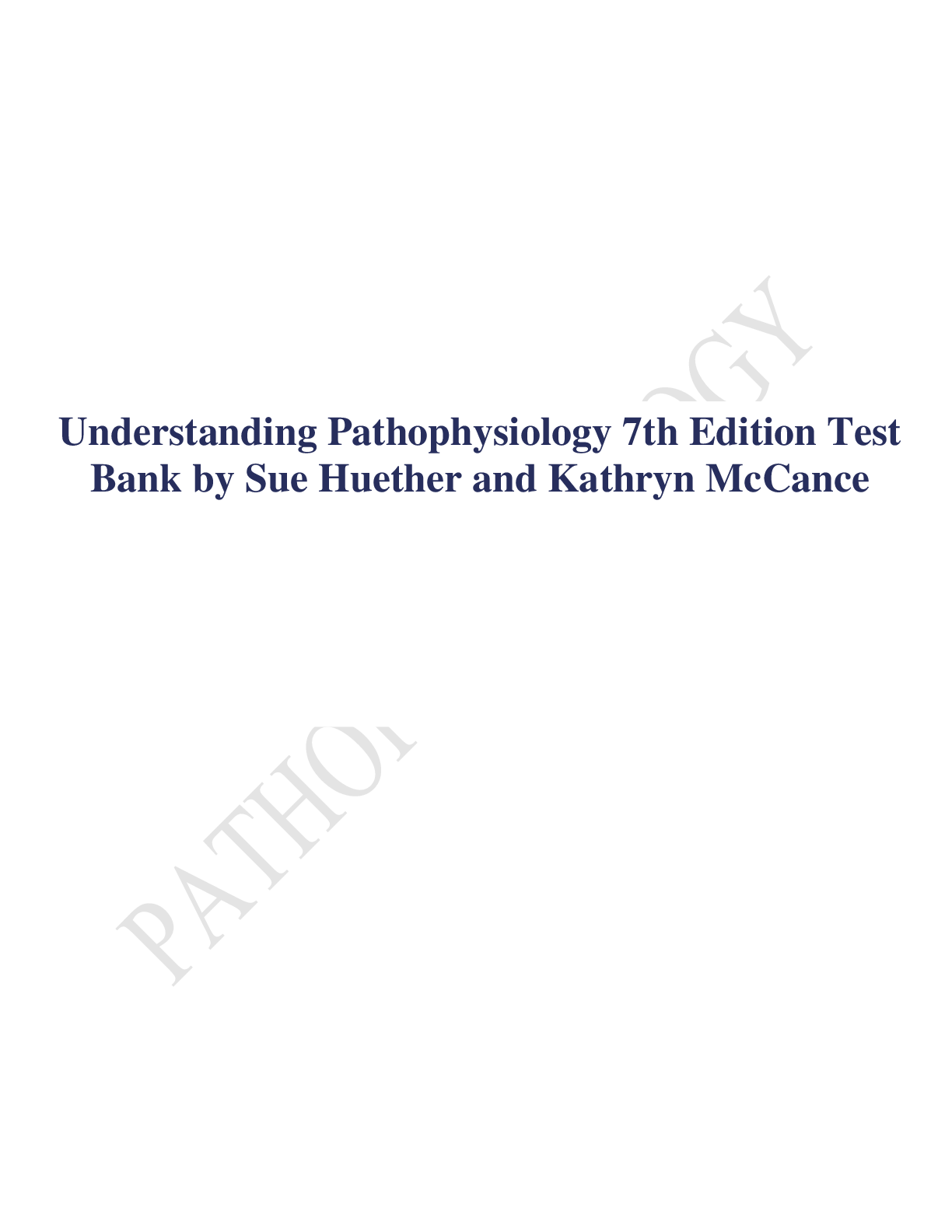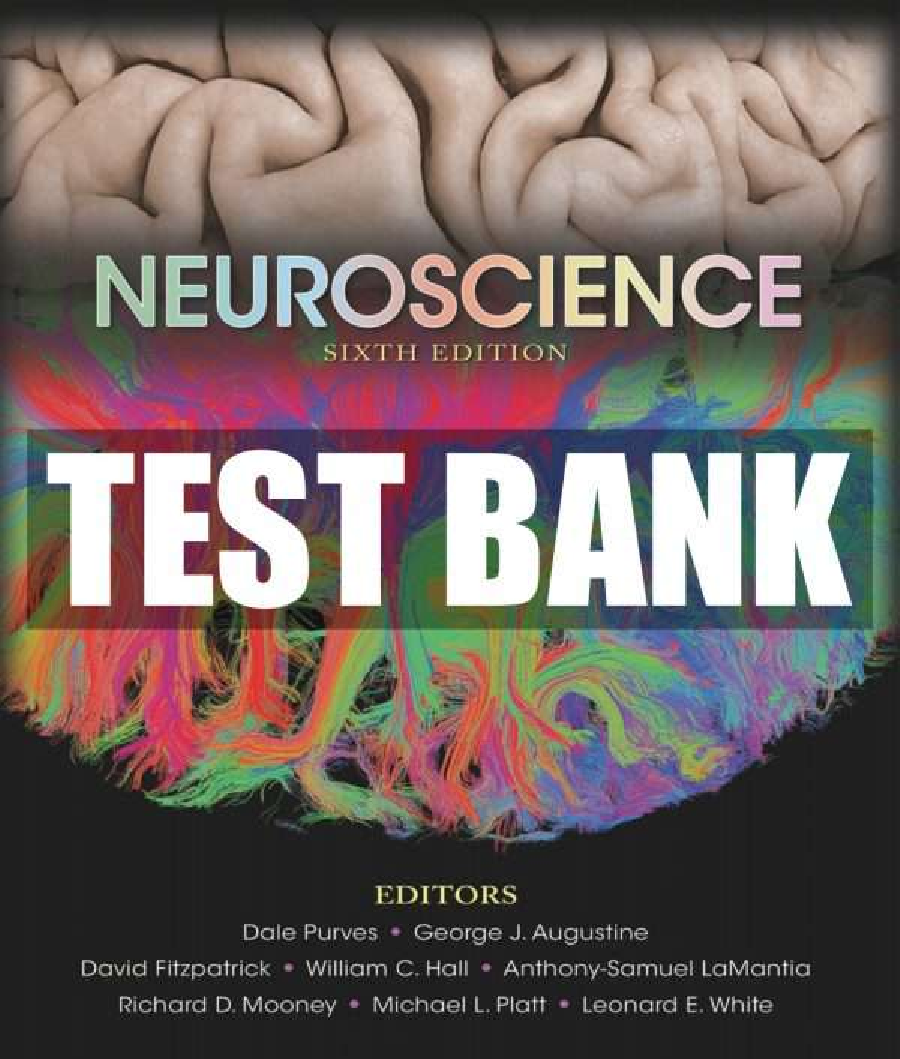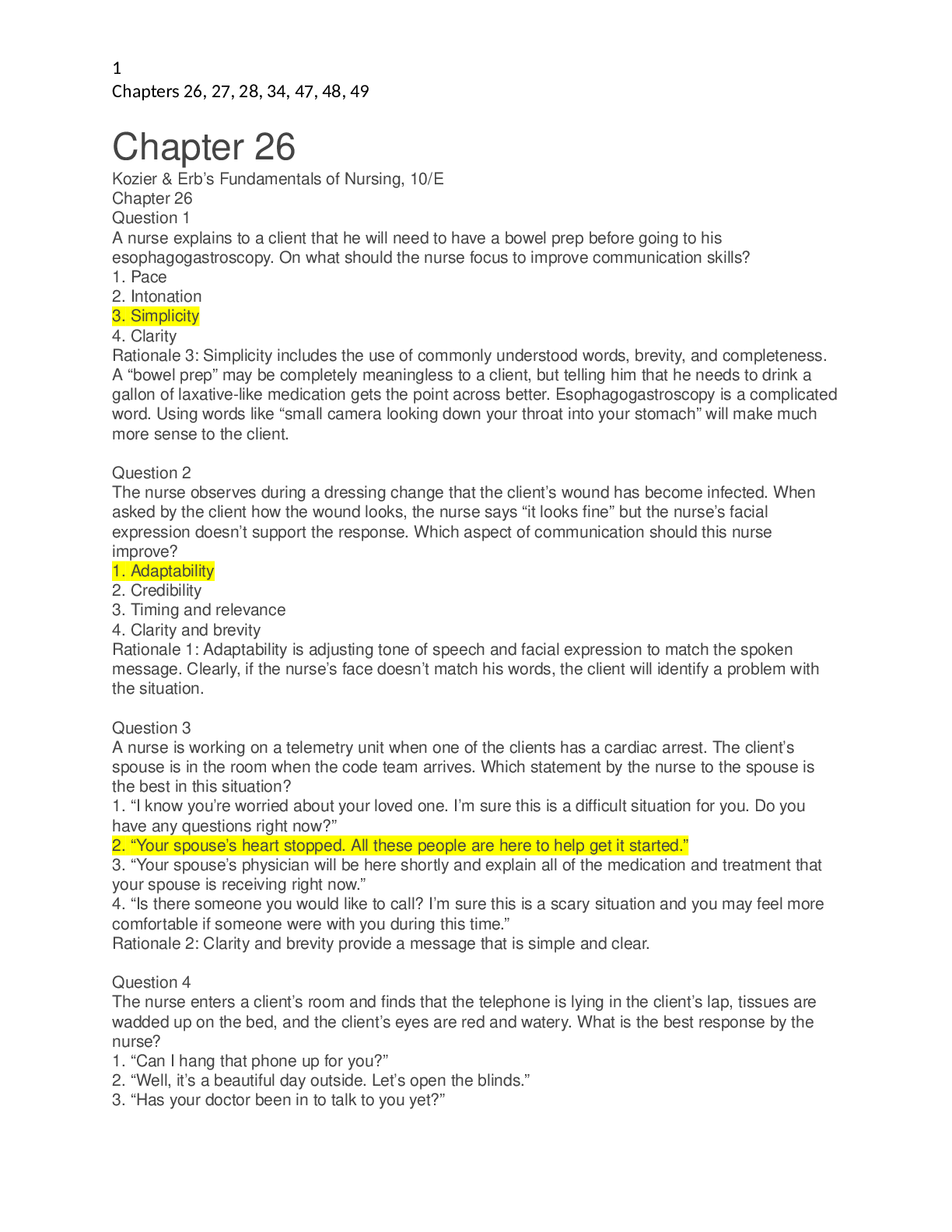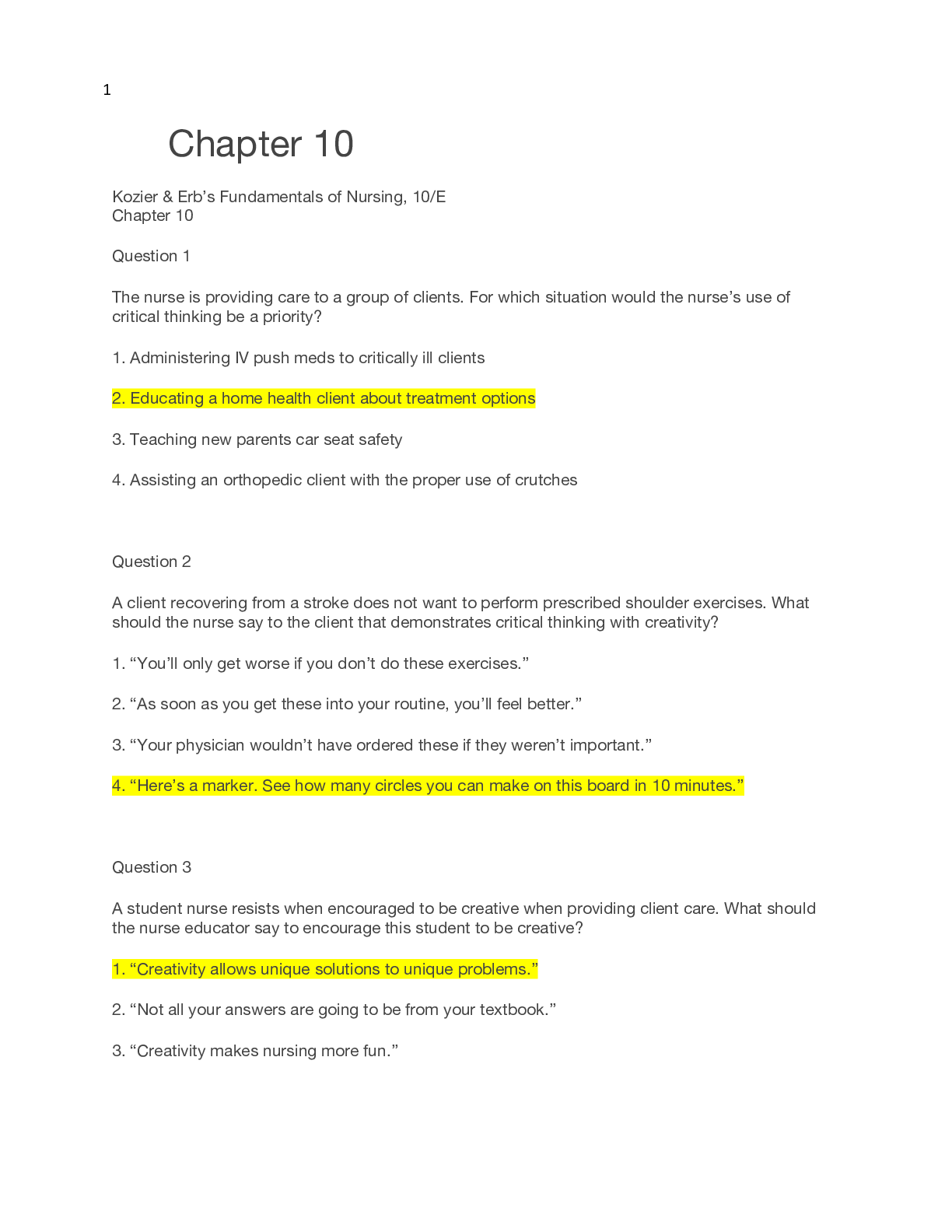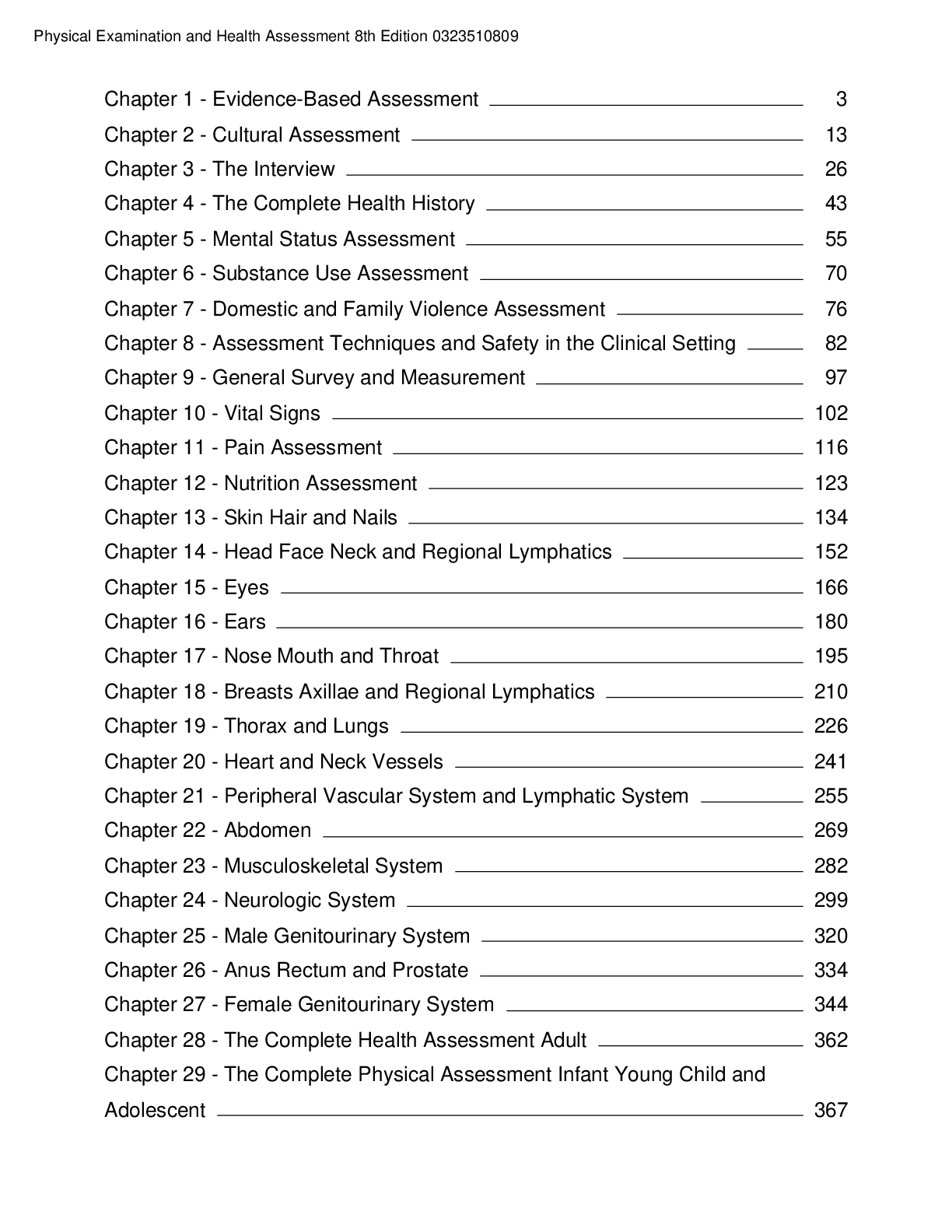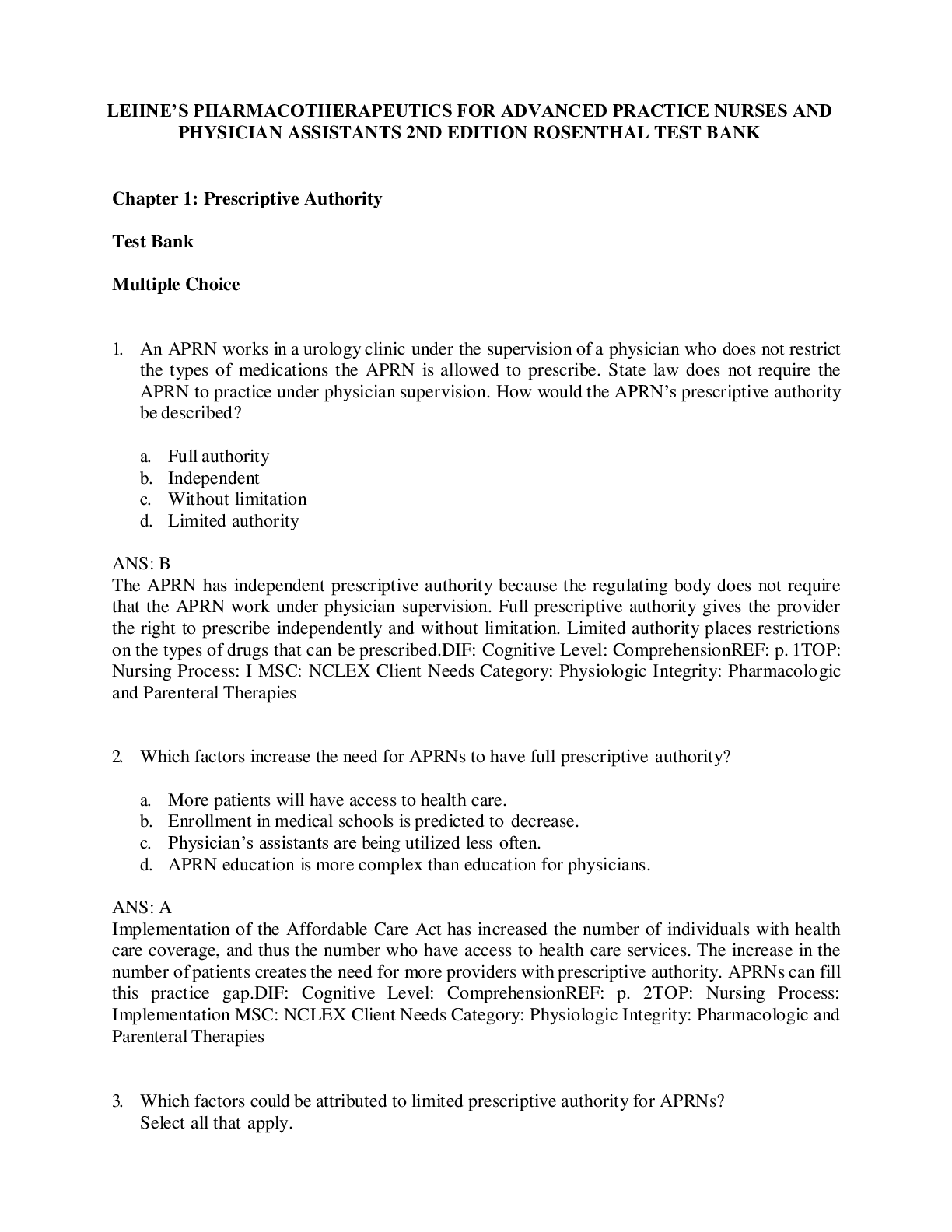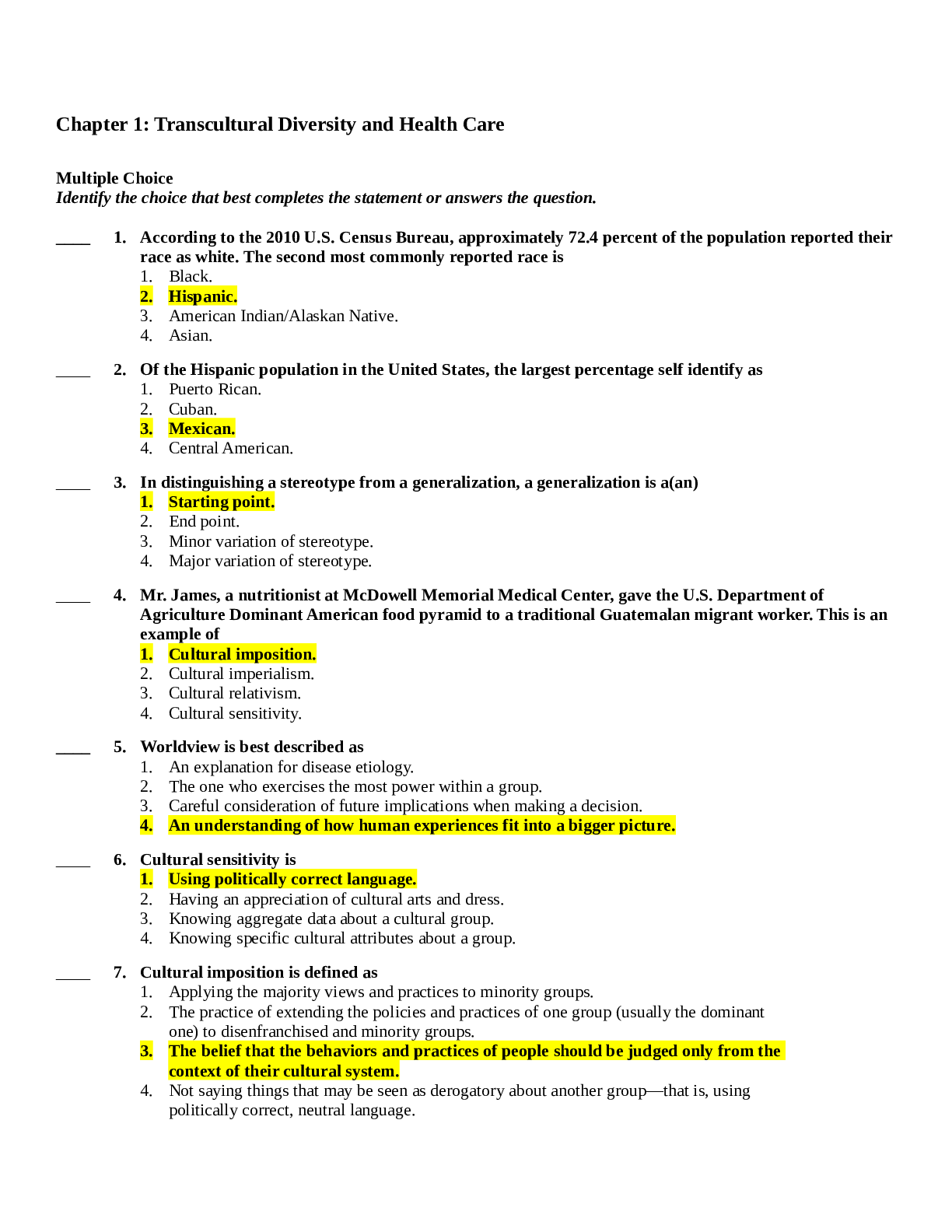*NURSING > TEST BANK > Burns' Pediatric Primary Care 7th Edition Test Bank with complete solution (All)
Burns' Pediatric Primary Care 7th Edition Test Bank with complete solution
Document Content and Description Below
Burns' Pediatric Primary Care 7th Edition Test Bank Chapter 1: Health Status of Children: Global and National Perspectives 1. Which region globally has the highest infant mortality rate? A. Indone sia... B. Southern Asia C. SubSaharan Africa Correct D. Syria 2. The primary care pediatric nurse practitioner understands that, to achieve the greatest worldwide reduction in child mortality from pneumonia and diarrhea, which intervention is most effective? A. Antibiotics B. Optimal nutrition C. Vaccinations Correct D. Water purification 3. Which is true about the health status of children in the United States? . 13348413856 A. Globalism has relatively little impact on child health measures in the U.S. B. Obesity rates among 2to5yearolds have shown a recent significant decrease. Correct . C. The rate of household poverty is lower than in other economically developed nations. D. Young children who attend preschool or day care have higher food insecurity. 4. The primary care pediatric nurse practitioner understands that a major child health outcome associated with worldwide climate change is A. cost of living. B. education. C. nutrition. Correct D. pollution. 5. When providing well child care for an infant in the first year of life, the primary care pediatric nurse practitioner is adhering to the most recent American Academy of PediatricsRecommendations for Preventive Pediatric Health Care guidelines by A. focusing less on development and more on illness prevention and nutrition. B. following guidelines established by theBright Futures publication. C. scheduling wellbaby visits to coincide with key developmental milestones. Correct D. seeing the infant at ages 2, 4, 6, and 12 months when immunizations are due. Chapter 2. Unique Issues in Pediatrics 1. A nurse is explaining the therapeutic milieu to a new nurse. The best explanation of this term would be: 1. The place where the child is receiving care.2. Group therapy. 3. Personal interactions between patients and staff. 4. All of the above are correct. ANS: 4 2. A 16-year-old male has received a pink-slip from the police for inpatient psychiatric treatment. The teen has been expressing thoughts of hanging himself because Life sucks. The nursing staff should consider placing the child: 1. With peers. 2. In an area where he can be watched one-on-one. 3. With a roommate that is expressing the same concerns. 4. In an area close to an external door. ANS: 2 3. Learning disabilities in children have scientifically been linked to: 1. Poor nutrition. 2. The environment in which the child lives. 3. Genetics. 4. Watching more than four hours of television a day. ANS: 3 4. A mental health nurse has assessed a child and determined that the child exhibits behavioral challenges. When the school nurse explains this to a teacher, the best description would be: . 1. The child may exhibit physical outbursts. 2. The child may exhibit violence toward others. 3. The child may be defiant or have tantrums. 4. The child will need special interventions for learning. ANS: 3 5. A child that has not exhibited enuresis in four years has exhibited this behavior pattern for the last week. The reason a child may revert back to this behavior pattern is because of: 1. Hallucinations. 2. Behavioral challenges. 3. Delusions. 4. Stress. ANS: 4 6. An 18-year-old male has called the crisis line for help. The crisis nurse recognizes the intervention needs may consist of all of the following except: 1. Discussing the individuals everyday activities. 2. Recognizing that the patient may be in a catharsis state. 3. Expressing empathy toward the caller. 4. Avoiding entropy. ANS: 1 7. An 8-year-old boy with a history of hallucinations and violent behavior has been place in a seclusion room at the hospital because he has been hurting others. The nurse checks on the patient and realizes she must take him out of the seclusion room when: 1. He is crying to be released.2. He states, I will be a good boy now. . 3. He starts headbutting the window. 4. He complains that his parents will file a lawsuit. ANS: 3 8. A child has been exhibiting the MacDonald Triad. These behaviors include: 1. Enuresis, pushing others, and pyromania. 2. Swinging a cat by the tail, bed-wetting, and lighting paper on fire in the trash can. 3. Playing with other children, laughing, and conversing with adults. 4. Playing with a campfire, watching television, and seeking adult attention. ANS: 2 9. A teenager diagnosed with borderline personality disorder should have discharge planning instructions of: 1. A consistent caregiver. 2. Monitoring of media, such as the Internet, television, and video games. 3. Obtaining support from family and friends. 4. Seeking medical attention when the teenager feels good. ANS: 3 10. A mental health nurse is teaching the mother of a child with executive functioning issues ways to help her child. Interventions the mother should use include: 1. Placing visual aids on the bathroom mirror so that the child will follow the morning routine. 2. Give the child a choice in foods to eat. 3. Allowing the child to ask for help when needed. 4. Reminding the child to be nice to others. ANS: 1 . 11. Ellie, a 9-year-old girl, was adopted by a family at the age of 4 after several years of severe neglect by her birth family. The adoptive family has been reporting that Ellie is angry a lot, manipulative with her teachers, and does not seek positive attention. The nurse working with Ellie will need to: 1. Provide education on decreasing stimuli in the home environment that triggers the anger. 2. Realize Ellie may have attachment issues related to her previous history and will need to encourage the family to be active in her care. 3. Support the family in the decision-making process of continuing to let Ellie live in the home. 4. Discuss inpatient therapy to decrease Ellies manipulative behavior patterns. ANS: 2 12. An infant displays depression by: 1. Smiling at strangers. 2. Bonding to someone other than the immediate family. 3. Crying more than an average infant. 4. Looks away when an adult attempts to play with the infant. ANS: 413. A father reports that his adolescent daughter has gotten good grades up until the last quarter of school. She has been hanging out by herself and does not want to talk to him anymore. The mental health nurse should: 1. Realize that this is a natural part of growing up. 2. Perform a mental health screening to check for depression. 3. Attempt to get the adolescent to discuss why she does not like her father anymore. 4. Let the adolescent talk when she is ready. ANS: 2 14. A teen should be checked for depression at __________ physician visit(s). 1. Every . 2. One 3. Monthly 4. Bi-yearly ANS: 1 15. When using the SAD FACES depression screen, it is important to assess: 1. Anhedonia. 2. Suicidal ideations. 3. Sleep patterns. 4. All of the above ANS: 4 16. A school nurse is giving an in-service to teachers on bullycide. The main reason for the teaching is so that: 1. Teachers are aware bullying occurs. 2. Teachers are able to identify students who are risk. 3. Teachers can be aware of the fact that suicides can happen due to bullying by others. 4. Teachers are aware of their role in causing bullycide. ANS: 3 17. An adolescent with a known history of bipolar disorder is in the school nurses office because a teacher reported that she was talking fast and acting like she was God. The school nurse assesses the girl and notes that: 1. She is probably in a manic phase and needs to be treated professionally. 2. She has had too much sleep and is now hyperactive. 3. She forgot to take her medications today. 4. She requires some food and rest before going back to class. ANS: 1 Chapter 3. Genetics and Child Health Questions 1. What is true about haploid cells? . 13348407644 C. Each contains 23 paired chromosomes. D. Each one contains 23 chromosomes. Correct E. Replication produces two identical cells.F. They replicate via the process of mitosis. 2. What does the following genetic notation symbol mean 47,XX,6q? . 13348407650 A. Male with deletion of chromosome 6 B. Female with deletion of chromosome 6 C. Male with deletion on the long arm of chromosome 6 D. Female with deletion on the long arm of chromosome 6 Correct 3. A child has a recessive genetic disorder that is homozygous for that mutation. . 13348407646 What is most likely about this child’s parents? A. Neither parent has a copy of that gene mutation. B. Only the mother has a copy of that gene mutation. C. Only the father has a copy of that gene mutation. D. Each parent has one copy of that gene mutation. Correct 4. Which type of mutation is responsible for many singlegene genetic disorders? . 13348407636 A. Copy number variations B. Nucleotide repeat expansions C. Point mutations Correct D. Single nucleotide polymorphisms (SNP) . 5. Cystic fibrosis is a recessive disease requiring the presence of a gene mutation . 13348407638 on both alleles inherited from the parents. Which type of genetic disorder is this? A. Chromosome B. Mitochondrial C. Monogenetic Correct D. Multifactorial . 6. The primary care pediatric nurse practitioner is counseling a couple about genetic risks and learns that one parent has neurofibromatosis, an autosomal dominant disorder, and the other parent does not. What will the nurse practitioner include when discussing this disorder and its transmission? C. Children must inherit a gene from both parents to develop the disease. D. Each child born to this couple will have a 50% risk of having the disease. Correct E. This type of disorder characteristically skips generations. F. Unaffected offspring may still pass on the disease to their offspring. 7. A family medical history conducted during a well baby exam for a newborn girl reveals that hemophilia A, an Xlinkedrecessive disorder, is present in males in three previous generations in the mother’s family, whose father had the disease. What will the primary care pediatric nurse practitioner tell the parents about the risk of this disease in their children? E. All of their sons will be affected by the disease. F. Any sons they have will not be affected by the disease. G. Daughters have a 50% chance of being carriers of the disease. Correct H. Their daughter has a 25% chance of having the disease. 8. What is an important responsibility of the primary care pediatric nurse practitioner . to help determine genetic risk factors in families? E. Assessing physical characteristics of genetic disorders F. Knowing which genetic screening tests to perform G. Making appropriate referrals to pediatric geneticists D. Obtaining a threegeneration pedigree for each family Correct 9. Which diagnostic study may be ordered when the provider wishes to detect the . presence of additional genetic material on a chromosome? A. Chromosomal microarray B. FISH Correct D. Karyotype E. Molecular testing 10. Which type of testing will the primary care pediatric nurse practitioner recommend . for a couple concerned about the potential for having children with cystic fibrosis? A. Biochemical testing B. Carrier testing Correct C. FISH testing D. Karyotype testing Chapter 4. Environmental Issues Questions 1. What has been the result of passage of the Toxic Substances Control Act. (TSCA) of 1976? G. A mandate for corporations to disclose known toxic chemicals H. A requirement that all manufactured chemicals undergo toxicity testing I. Authorization of the EPA to require testing and reporting of some chemicals Correct J. Development of a mechanism to report reactions to toxic chemicals 2. Many European nations use the “precautionary principle” to help regulate potentially toxic chemicals. What does this mean? G. Chemicals must be proven to be safe before being introduced into theenvironment. Correct H. Corporations may be exempt from testing if their costs in doing so are too high. I. Regulators must demonstrate risk to the public before banning a chemical. J. Without a strong risk, corporations need not release data about their products. 3. During a clinic visit, a child’s rapid capillary screening test for lead reveals a level of 11 mcg/dL. What will the primary care pediatric nurse practitioner do next? I. Institute lead abatement measures in the child’s home. J. Monitor lead levels monthly until decreased. K. Order a venous sample to test for lead levels. Correct L. Test the child’s siblings and parents for lead. 4. A child has a lead level of 25 mcg/dL. Once lead abatement measures are instituted, what is an important intervention to help prevent permanent damage H. Chelation therapy I. Dietary changes C. Followup testing Correct . D. Testing family members 5. A child whose parent works in a factory pr esents with swelling of the extremities, pain and weakness in the pelvis, and an erythematous maculopapular rash. Which industrial toxin will the primary care pediatric nurse practitioner suspect in this child? A. Lead B. Mercury C. Organophosphates Correct D. Phthalates 6. When counseling a mother who smokes about preventing exposure to smokingrelated risks to her nursing newborn, what will the primary care pediatric nurse practitioner tell her? F. If she quits now, her child will not have longterm effects from exposure. G. Prenatal smoke exposure does not cause respiratory effects after the infant is born. H. Smoking outdoors or near an open window prevents exposure to tobacco smoke. I. Thirdhandsmoke exposure risks may last for years even if the mother quits now. Correct 7. A child who has been playing in a public park is brought to the clinic with wheezing, vomiting, diarrhea, and drooling. A physical exam reveals a low heart rate and diaphoresis. What will the primary care pediatric nurse practitioner suspect as a cause for these symptoms? B. Arsenic consumption C. Lead poisoning C. Organophosphate exposure Correct D. Phthalate ingestion 8. A parent asks about ways to limit exposure to risks associated with plastics.Besides avoiding using plastic containers when possible, what else will the primary care pediatric nurse practitioner recommend? A. Avoid heating foods and liquids in plastic containers. Correct B. Clean plastic containers well using the dishwasher. C. Use only plastics stamped with “#7” on the bottom. D. Used canned food products whenever possible. 9. A parent desires to buy only organic produce to avoid exposing a child to pesticides but complains that these foods are expensive. The primary care pediatric nurse practitioner provides a list of foods that are relatively safe whether they are organic or not. Which foods are on this list? A. Apples, celery, and peaches B. Potatoes, cherry tomatoes, and peaches C. Strawberries, grapes, and cucumbers D. Sweet corn, cantaloupe, and kiwi Correct Chapter 5. Child and Family Health Assessment Questions 1. The primary care pediatric nurse practitioner is obtaining a medical history about a child. To integrate both nursing and medical aspects of primary care, which will be included in the medical history? K. Complementary medications, alternative health practices, and chief complaint L. Developmental delays, nutritional status, and linear growth patterns M. Medication currently taking, allergy information, and family medical history N. Speech and language development, beliefs about health, and previous illnesses Correct 2. When formulating developmental diagnoses for pediatric patients, the primary care pediatric nurse practitioner may use which resource? A. DC: 03R Correct K. ICD10CM L. ICSD3 M. NANDA International 3. The primary care pediatric nurse practitioner sees a 3yearold child who chronically withholds stools, in spite of the parents’ attempts to stop the behavior, requiring frequent treatments with laxative medications. Which diagnosis will the nurse practitioner use to facilitate thirdparty reimbursement? M. Altered elimination pattern N. Elimination disorder C. Encopresis Correct D. Parenting alteration 4. The primary care pediatric nurse practitioner is assessing a toddler whose weight and body mass index (BMI) are below the 3rd percentile for age. The nurse practitioner learns that the child does not have regular mealtimes and is allowed to carry a bottle of juice around at all times. The nurse practitioner plans to work with this family to develop improved meal patterns. Which diagnosis will the nurse practitioner use for this problem?J. Failure to thrive K. Home care resources inadequate L. Nutrition alteration – less than required D. Parenting alteration Correct . 5. The primary care pediatric nurse practitioner is p erforming a well child checkup on a 20monthold child. The child was 4 weeks premature and, according to a parentcompleted developmental questionnaire, has achieved milestones for a 15monthold infant. Which action is correct? J. Perform an indepth developmental assessment screen at this visit to evaluate this child. Correct K. Reassure the parent that the child will catch up to normal development by age 2 years. L. Reevaluate this child’s development and milestone achievements at the 2year visit. M. Refer the child to a specialty clinic for evaluation and treatment of developmental delay. 6. The primary care pediatric nurse practitioner performs a developmental assessment on a 3yearold child and notes normal cognitive, finemotor, and grossmotor abilities. The child responds appropriately to verbal commands during the assessment but refuses to speak when asked questions. The parent tells the nurse practitioner that the child talks at home and that most other adults can understand what the child says. The nurse practitioner will D. ask the parent to consider a possible speech delay and report any concerns. E. continue to evaluate the child’s speech at subsequent visits. Correct F. refer the child for a speech and hearing evaluation. G. tell the parent to spend more time in interactive conversations with the child. 7. The parent of a toddler is concerned that the child may have autism. The primary care pediatric nurse practitioner completes a Modified Checklist for Autism in Toddlers (MCHAT) tool, which indicates several areas of concern. What will the nurse practitioner do? E. Administer a Childhood Autism Rating Scale (CARS) in the clinic. F. Consult a specialist to determine appropriate early intervention strategies. G. Refer the child to a behavioral specialist for further evaluation. Correct H. Tell the parent that this result indicates that the child has autism. 8. The primary care pediatric nurse practitioner learns that the mother of a 3yearold child has been treated for depression for over 5 years. Which aspect of this child’s development will be of the most concern to the nurse practitioner?D. Fine motor E. Gross motor F. Social/emotional D. Speech and language Correct . 9. When meeting with a new family, the primary care pediatric nurse practitioner develops a database that identifies family members and others living in the household, relationships with others outside the household, and significant behavioral and emotional problems. Which tool will the nurse practitioner use to record this information? C. CRAFFT D. Ecomap C. Genogram Correct D. Pedigree 10. A child is in the clinic for evaluation of an asthma action plan. The primary care pediatric nurse practitioner notes that the child’s last visit was for a prekindergarten physical and observes that the child is extremely anxious. What will the nurse practitioner do initially? A. Ask the child’s parent why the child is so anxious. B. Perform a physical assessment to rule out shortness of breath. C. Reassure the child that there is nothing to be afraid of. D. Review the purpose of this visit and any anticipated procedures. Correct 11. The primary care pediatric nurse practitioner is evaluating health literacy in the mother of a new preschoolage child. How will the nurse practitioner assess C. Ask the child how many books he has at home. Correct D. Ask the mother about her highest grade in school. E. Ask the mother to determine the correct dose of a drug from a label. F. Ask the mother to read a health information handout aloud. 12. The mother of a newborn tells the primary care pediatric nurse practitioner that she is worried that her child will develop allergies and asthma. Which tool will the nurse practitioner use to evaluate this risk? A. Threegeneration pedigree Correct A. Review of systems B. Genogram C. Ecomap 1 3. The primary care pediatric nurse practitioner is performing a well child assessment on an adolescent and is concerned about possible alcohol and tobacco use. Which assessment tool will the nurse practitioner use? A. CRAFFT Correct A. HEEADSSS B. PHQ2 C. RAAPS14. The primary care pediatric nurse practitioner evaluates a schoolage child whose body mass index (BMI) is greater than the 97th percentile. The nurse practitioner is concerned about possible metabolic syndrome and orders laboratory tests to evaluate this. Which diagnosis will the nurse practitioner document for this visit? A. Metabolic syndrome B. Nutritional alteration: more than required C. Obesity Correct A. Rule out type 2 diabetes mellitus Chapter 6. Cultural Considerations for Pediatric Primary Care Questions 1. The primary care pediatric nurse practitioner provides well child care for a community of immigrant children from Central America. The pediatric nurse practitioner is surprised to learn that some of the families are Jewish and not Catholic. This response is an example of cultural O. collectivism. P. constructivism. Q. essentialism. Correct R. individualism. 2. The primary care pediatric nurse practitioner learns that an AfricanAmerican family lives in a neighborhood with a high crime rate and suggests that they try moving to another neighborhood for the safety of their children. This is an example of N. cultural sensitivity. O. group bias. P. individual privilege. Correct Q. racial awareness. 3. The primary care pediatric nurse practitioner cares f or children from a Native American family and learns that they used many herbs to treat and prevent illness. Which approach will the pediatric nurse practitioner use to promote optimum health in the children? O. Ask about the types of practices used and when they are applied. Correct P. Provide a list of harmful herbs and ask the family to avoid those. Q. Suggest that the family avoid using these remedies in their children. R. Tell the parents to use the herbs in conjunction with modern medications. 4. The primary care pediatric nurse practitioner works with families from a variety of cultures and socioeconomic classes. Which is an example of cultural humility in practice? M. Giving health care advice that takes cultural differences into account N. Identification of other cultures that may be superior to one’s own culture C. Receptivity to learning about the perspectives of other cultures Correct D. Respecting other cultures while maintaining the views of one’s own 5. A Somalian immigrant mother is concerned that her 8yearoldchild is underweight. The primary care pediatric nurse practitioner notes that the child’s weight is at the 25th percentile. After realizing that the mother is comparing her child to a group of Americanborn children who are overweight, the pediatric nurse practitioner is able to convince the mother that this is a normal weight. Which domain of cultural competence does this represent? A. Global B. Interpersonal Correct N. Intrapersonal O. Organizational 6. The primary care pediatric nurse practitioner in a community health center meets a family who has recently immigrated to the United States who speak only Karon. They arrive in the clinic with a church sponsor, who translates for them. The pediatric nurse practitioner notices that the sponsor answers for the family without giving them time to speak. The pediatric nurse practitioner will H. ask the sponsor to allow the family to respond. I. develop the plan of care and ask the sponsor to make sure it is followed. J. request that the sponsor translate written instructions for the family. K. use the telephone interpreter service to communicate with the family. Correct 7. The primary care pediatric nurse practitioner prescribes a twice daily inhaled corticosteroid for a 12yearold child. At a well child visit, the child reports not using the medication on a regular basis. Which response by the pediatric nurse practitioner demonstrates an understanding of clientcentered care? A. Asking the child to describe usual daily routines and schedules Correct I. Referring the family to a social worker to help with medication compliance J. Reviewing the asthma action plan with the parent and the child K. Teaching the child how the medication will help to control asthma Symptoms 8. A primary care pediatric nurse practitioner working in a community health center wishes to develop a program to assist impoverished children and families to have access to healthy foods. Which strategy will the pediatric nurse practitioner employ to ensure the success of such a program? G. Asking community members to assist in researching and implementing a program Correct H. Designing a community garden approach that involves children and their parents I. Gaining support from the corporate community to provide needed resources J. Providing evidencebased information about the importance of a healthy diet 9. The parents of a special needs child tell the primary care pediatric nurse practitioner that they are planning a 3monthvisit to their home country in Africa. The pediatric nurse practitioner assists the family to obtain a sufficient supply of medications and formula and to make sure that the child’s equipment can be transported and used during the trip and at the destination. This is an example of E. global application. Correct F. global awareness. G. system application. H. system awareness. 10. The primary care pediatric nurse practitioner is examining a child whose parents recently emigrated from a wartorn country in the Middle East. Which is a priority assessment when performing the patient history? A. Asking about physical, psychological, and emotional trauma Correct E. Determining the parents’ English language competency and literacy level F. Learning about cultural preferences and complementary medicine practices G. Reviewing the child’s previous health and illness records Chapter 7. Children with Special Health Care Needs 1. A child born with Dandy Walker malformation is receiving palliative care in the pediatric unit. A nurse should: 1. Provide the parents, patient, and family members with supportive care during this time. 2. Ask the parents to be part of the plan of care as much as possible. 3. Attempt to provide a primary nurse for this particular patient on each shift. 4. All of the above are correct. ANS: 4 2. A head circumference is being measured at a 4 month olds well-baby checkup. It is noted that the head circumference has not grown since the previous assessment. The nurse should: 1. Ask the mother about the childs nutrition. K. L. . M. N. . 2. Notify the doctor. 3. Re-measure the head circumference, check developmental milestones, assess the nutritional status, and discuss the findings with the doctor. 4. Document the normal findings. ANS: 3 3. A child with a diagnosis of schizencephaly is assigned to a new nurse on the pediatric floor. The new nurse has not worked with a child with this diagnosis before. A career nurse discusses the plan of care needed for the child with the new nurse. It will be important to: 1. Assess the side of the body that has paralysis for any lesions or sores. 2. Let the patient do as much as possible for activities of daily. 3. Discourage the patient to move the paralyzed side of the body. 4. Provide full care for the patient. ANS: 1 4. A nurse is assessing a 6-month-old boys suture lines. The nurse notes that the baby hascraniosynostosis. The nurse should be concerned because: 1. The suture line closure will not allow the brain to grow. 2. This can lead to hydrocephalus. 3. The child will have immediate developmental delays because of the lack of space for the brain to grow. 4. The child will not require surgery. ANS: 1 5. A child that had a shunt placed four years ago for hydrocephalus is in the emergency room complaining of a rapid onset of vomiting and increased lethargy. The nurse knows that the child will need: 1. Nothing, as this is a normal complication and not an emergency. 2. To be placed on IV fluids to help maintain an electrolyte balance. 3. Small amounts of fluids until the vomiting has subsided. 4. To consider this a neurological medical emergency and check the childs head circumference. ANS: 4 6. Night terrors can occur in adolescents because of: 1. Emotional stress. 2. Alcohol use. 3. Bullying. 4. All of the above can trigger night terrors in adolescents. ANS: 4 7. When speaking with a family about their 9-year-old daughters nightmares, it is important to ask: 1. If the child has a history of daytime napping. 2. What medications the child takes during the day. 3. How often the child consumes caffeine. 4. All of the above should be part of the assessment. ANS: 4 8. A quality of a partial seizure is: 1. Status epilepticus. 2. Tonic movements. 3. Fluttering eyelids. 4. Clonic movements. ANS: 4 9. A mother is asking the nurse why her daughter continues to have temporal lobe seizures even though she is on medication. The nurse knows this is occurring because: 1. The medication may not be in the therapeutic range. 2. Temporal lobe seizures do not respond well to medications. 3. The daughter may be missing doses of her medication. 4. The food her daughter eats may have a negative reaction with the medication, causing more seizures. ANS: 2 10. Which of the following types of epilepsy are photosensitive? 1. Juvenile myoclonic epilepsy 2. Temporal lobe epilepsy 3. Febrile seizures 4. Childhood absence epilepsy ANS: 1 1. A child who had a seizure one hour ago is exhibiting signs of paralysis on the left side of the body.The nurse understands the child is exhibiting signs of: 1. Lethargy due to previous seizure activity. 2. Postictal paralysis. 3. Permanent paralysis of the left side of the body. 4. Major brain damage that is going to have long-term effects. ANS: 2 12. A child with a known history of Benign Rolandic Epilepsy is having a seizure during lunch at the middle school. The school nurse is called to the cafeteria. What is the school nurses priority at this time? 1. Prevent a possible choking incident by checking the students mouth for food. 2. Lay the child down on the floor and make sure the area is safe. 3. Call the EMTs for help. 4. Notify the parents that their daughter is having a seizure. ANS: 1 . 13. An 18 month old is having a seizure when the nurse is assessing him. The nurse notes that the child is fluttering his eyes and smacking his lips. The nurse should document this seizure as: 1. An absence seizure. 2. A tonic-clonic seizure. 3. A myoclonic seizure. 4. A febrile seizure. ANS: 1 14. A 9 month old is admitted to the pediatric unit for seizures of unknown origin. The child has an EEG performed for several hours. The EEG notes several seizures occurring at different intervals. The nurse knows this child: 1. Will develop at the same rate as his peers. 2. May have severe mental and physical challenges due to the frequent seizure activity. 3. May exhibit a slight cognitive delay as he grows. 4. Will grow out of having seizures. ANS: 2 15. A child has been status epileptics for the last 20 minutes. The child has Depakote, Valporic Acid, and Diazepam gel ordered. The nurse should prepare which medication for administration at this time? 1. Depakote 2. Valporic acid 3. Diazepam 4. None of the medications. The child will stop on his own. ANS: 3 16. Care for a child during status epilepticus should include all of the following except: 1. Turn the patient to the right side. 2. Loosen tight clothes. 3. Move toys out of the area to prevent injury. 4. Stay with the patient until the seizure has stopped. ANS: 117. The nurse is identifying the difference between primary headaches to secondary headaches. Secondary headaches can occur: 1. Because of stress. 2. In relation to low blood pressure. 3. Because of concussions. 4. Because of migraines. ANS: 3 18. Cyclic vomiting may: 1. Last for days. 2. Require SSRIs to stop hurting. 3. Not be associated with a headache. 4. Requires pain medication and Zofran. ANS: 3 19. A child that has rhythmic, repetitive, involuntary movements is exhibiting: 1. Tremors. 2. Dystonia. 3. Contractures. 4. Tics. ANS: 2 20. Identify a therapeutic management technique for a child with a tic disorder. 1. Behavioral modification to suppress the tics 2. Administer anti-psychotic medications to reduce the tics 3. Education and support for the child and the family 4. Genetic counseling for the family ANS: 3 21. Identify a true statement about Tourettes Syndrome (TS) is that: 1. Manifestations rarely change once developed. 2. Children with TS do not have obsessive compulsive disorders. 3. The tics of TS can lead to mental deterioration. 4. The tics are involuntary, and the person cannot control the behavior. ANS: 4 22. The assessment a nurse performed on a 12-year-old boy demonstrated a positive Kernigs sign and a Brudzinskis sign. Identify the priority for the nurses next action. 1. Document the findings and note as normal. 2. Further assess the neurological function of the child and call the doctor with a report. 3. Explain to the patient that the assessment was abnormal and there is no a cause for concern. 4. Prepare the child for a lumbar puncture. ANS: 2 23. Results from cerebrospinal fluid that was tested for meningitis have been received by the nurse. The results indicate bacterial meningitis. The nurse knows this because the results show: 1. A low protein count and a low glucose count. 2. A low red blood cell count. 3. An elevated protein count and a low glucose level. 4. A normal protein count and a high glucose count. ANS: 3. Chapter 8. Developmental Management in Pediatric Primary Care Questions 1. A single mother of an infant worries that living in a household with only one parent will cause her child to be maladjusted. To help address the mother’s concerns, the primary care pediatric nurse practitioner will suggest S. developing consistent daily routines for the child. Correct T. exposing her child to extended family members when possible. U. not working outside the home during the first few years. V. taking her child to regular play date activities with other children. ........................CONTINUED..........DOWNLOAD TO BOOST YOUR GRADES........... [Show More]
Last updated: 1 year ago
Preview 1 out of 135 pages
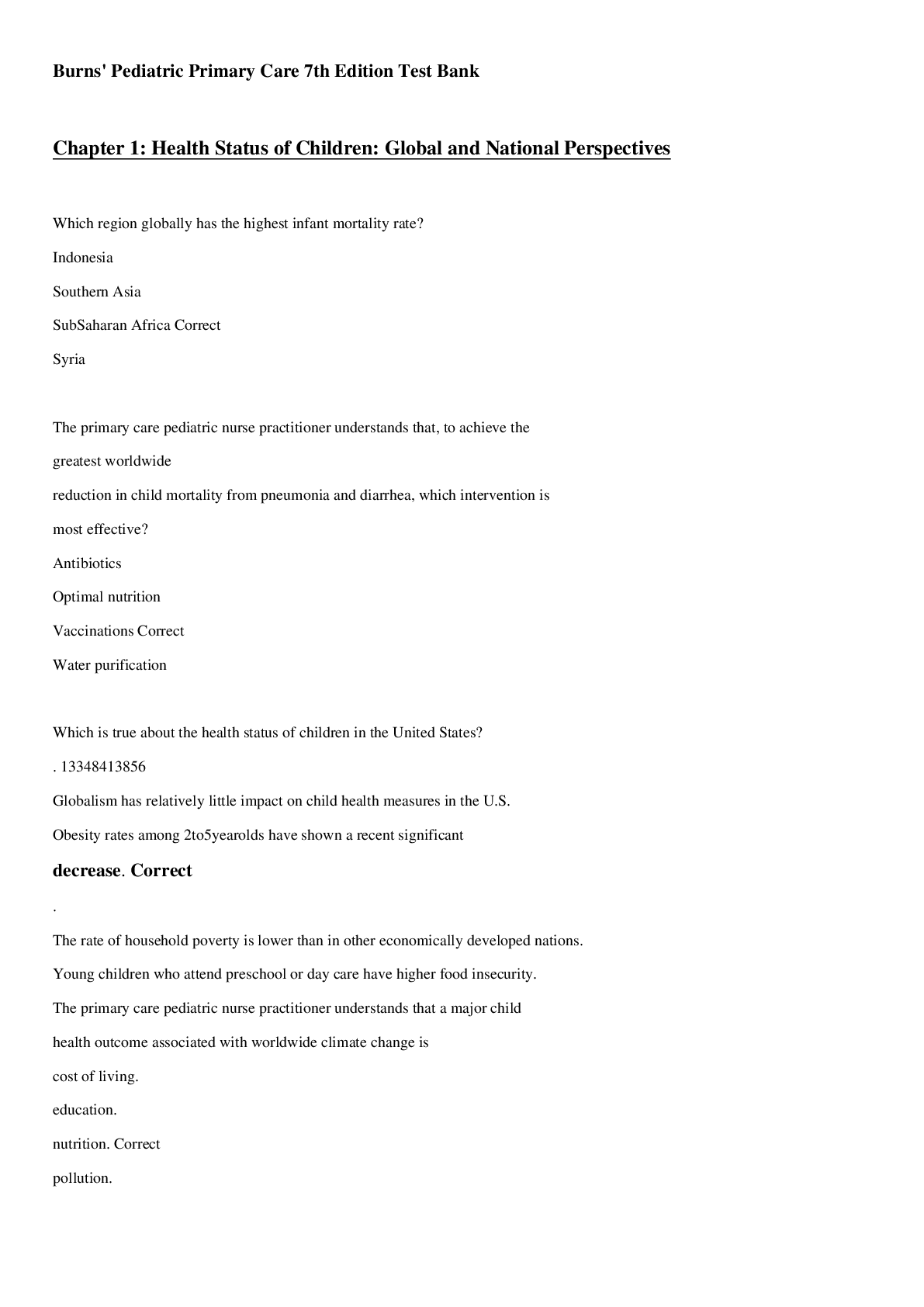
Buy this document to get the full access instantly
Instant Download Access after purchase
Add to cartInstant download
We Accept:

Reviews( 0 )
$12.00
Document information
Connected school, study & course
About the document
Uploaded On
May 11, 2021
Number of pages
135
Written in
Additional information
This document has been written for:
Uploaded
May 11, 2021
Downloads
0
Views
51





